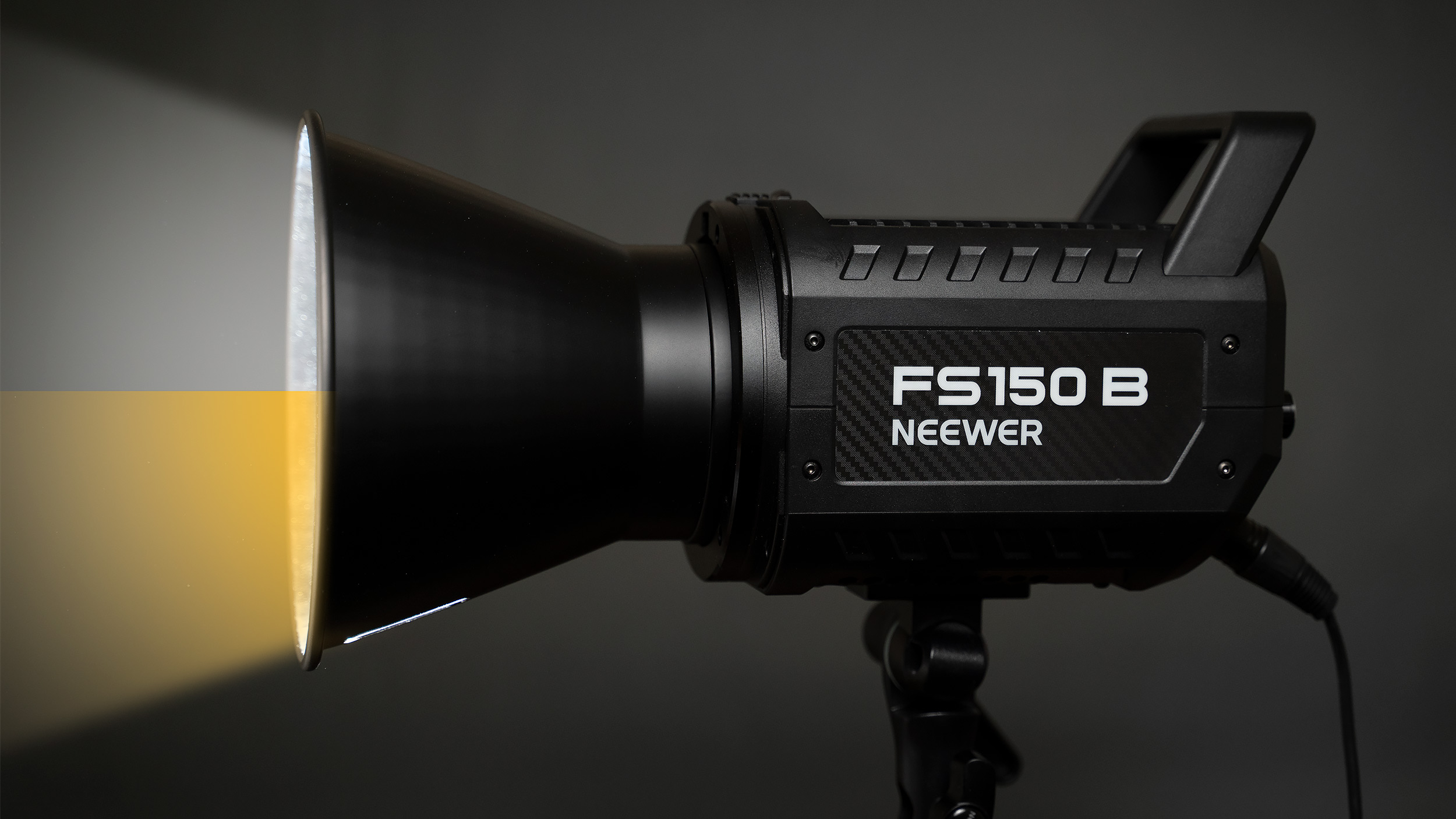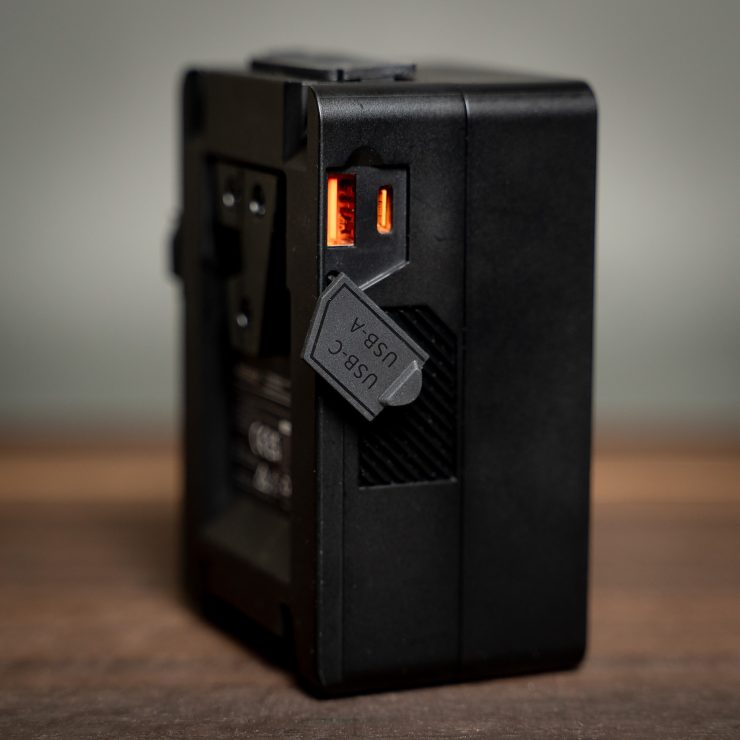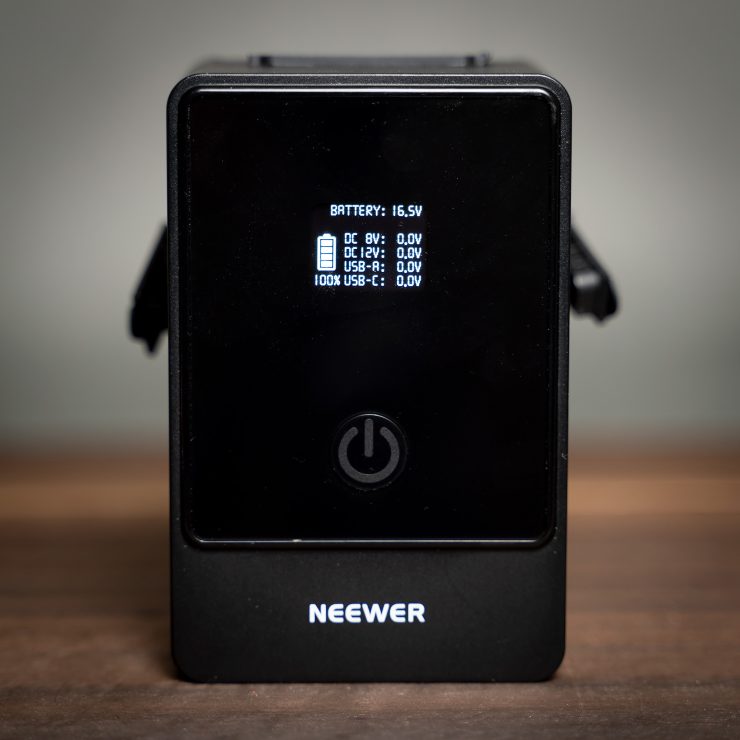Like most photographers, I’ve been shooting a lot more video over the past few years. Though I’ve owned plenty of strobes and monolights, my first LED monolight for shooting video was a Godox SL60W, which has been reliable and produced great light quality, but it lacks power and it’s annoyingly noisy. When I started looking for a replacement, I first considered the Godox UL150 II Bi-Color Silent LED Video Light for the power and quiet operation, but fortuitously also learned of the Neewer FS150B Bi-Color LED Video light at the same time, so I contacted Neewer and requested a unit to review.
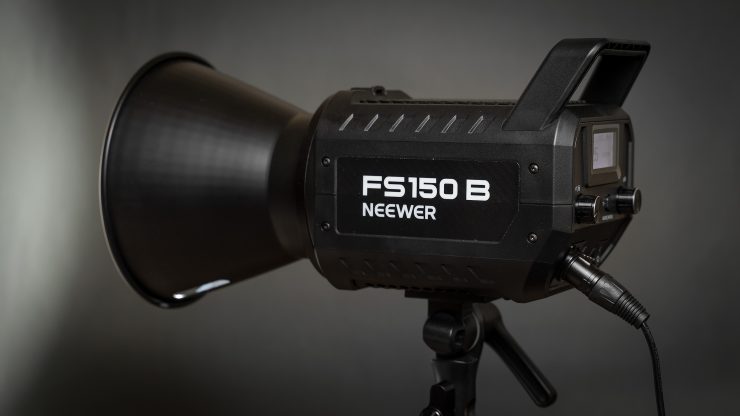
And I’m glad that I did. The Neewer light is roughly half the price of the (already reasonable) Godox, with an excellent feature set and tons of flexibility. But do we have to sacrifice quality with the Neewer? So far, it doesn’t look like it. The Neewer appears to be sturdy enough and full-featured, but lets take a closer look at the details and see how good it really is.
Most Important: Light Quality and Color
Any decent video lighting manufacturer today provides a Color Rendering Index (CRI) rating for their LED lights, and Neewer is no different. The questions is, can we trust them? And how much do they vary across the light’s color range? Let’s see.
For these tests, I’m using a Sekonic C-700R-U SpectroMaster Color Meter.


As a warm up, I decided to test an inexpensive old battery-powered multi-LED video light that was lying around. I bought a pair from Amazon in 2017 and they’re no longer sold, but these ones are similar and cost $65. Mine claimed to have a color temperature of 5600K, but they didn’t provide a CRI rating. According to the Sekonic, the color temp. is pretty close at 5488K, but with a CRI of only 89.
My old Godox SL60W claims to produce a color temperature of 5600K with a CRI of 95+. After giving the Godox several minutes to warm up, its color temperature read as 5454K, somewhat warmer than expected, but with an excellent CRI of 97.1.
The Neewer FS150B is brand new and claims to have a temperature range of 2700 to 6500. Though the “150” in the name suggests that it’s a 150W light, it’s actually a 130W light, with an output of 72000lux/1m. How close is it?
Again, with the color temperature set to 5600K and 50% power, I took five readings that averaged 5632K, which is remarkably close to the expected color, and that with a CRI of 97.2. Next, I set the color to 6500K and took three more readings which averaged 6570K, again, very close… just slightly cooler than desired, this time with a CRI of 96.3. Turning the dial the opposite direction, I set the color to 2700K, and my meter readings showed an actual color of 2645K and a CRI of 96.8.
| Power Level | CRI | Color Temp. (K) |
|---|---|---|
| 10% | 97 | 5215 |
| 25% | 97.5 | 5578 |
| 50% | 97.2 | 5507 |
| 75% | 97.1 | 5478 |
| 100% | 96.8 | 5460 |
The Neewer FS150B was set to 5600K for all measurements.
I’m really very impressed with the color accuracy of the Neewer FS150B, and while the CRI dips slightly at the extremes of the color spectrum, that’s to be expected when the color of light is not balanced, and the CRI remains well above 95, which, again, is excellent. So, when it comes to light quality, the Neewer FS150B is as good as I could have hoped, and I’d be confident in it for regular professional use.
Design & Build Quality

Body & Mount
The body of the FS150B is primarily made of a sturdy plastic with a metal lower grate and base plate. A well designed handle rising above the back edge of the light is also made of plastic but feels nice and strong.
The FS150B gets its power via a locking 3-pin XLR jack, so there’s little chance of the plug accidentally being pulled out. Unfortunately, on the Neewer power supply, the cable between the XLR jack and the transformer brick is only 6 feet long, and my light is usually mounted atop a 7 or 8 foot stand, so the full weight of the power brick is dangling from that jack unless I strap it to the light stand. All of this stress on the jack could have been avoided with a few more cents worth of wire and a bit of foresight.

An umbrella mount is built into the upper portion of the light-stand mount, and there’s a hole in the supplied reflector with a matching offset to allow an umbrella to pass through. The mount doesn’t have a locking screw (and I’d prefer one), but I haven’t had any problems with it either.
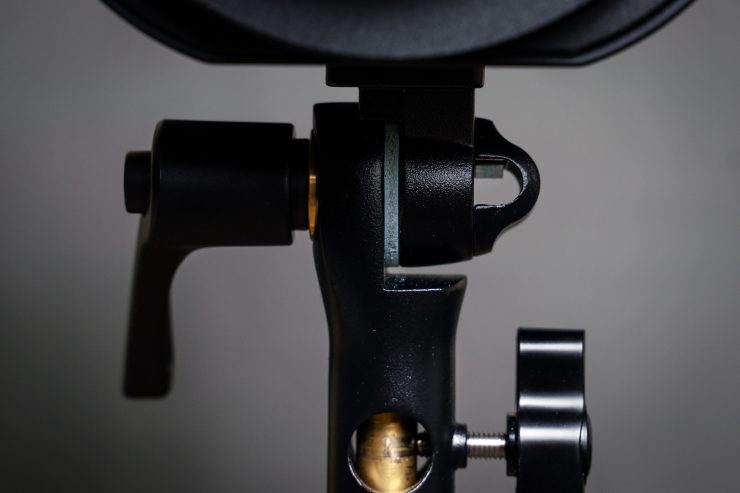
I have had mixed results with the Bowens mount. My soft boxes all mount up to it with no issues, but for some reason, the reflector that shipped with my Godox (also Bowens mount) won’t lock into it at all. This is only an issue because the Neewer supplied reflector is very directional (it focuses the output into a fairly tight spot), making it less than ideal for use with shoot-though umbrellas. Luckily, the LED is set back into the head far enough that I can shoot without a reflector in most cases.
Fan Noise? Nope.
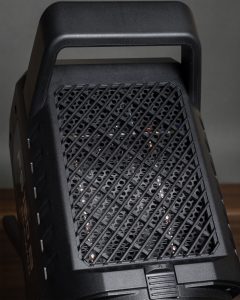
I shoot a lot of video of small objects, often at macro range, and for these it’s usually helpful to get the light in pretty close to the camera, so fan noise can be a serious concern. The fan noise of my Godox often required me to mute the live audio and replace it with music and voiceover and/or sound effects in post.
Using a decibel meter on my phone (an admittedly crude way to measure, but it’s what I had available), placed about 6 inches from both lights, turned on at 50% power, I took noise measurements for several minutes (the app kept a running average). The background noise (here in the city) is about 23.6db. Turning on the Neewer, the fan didn’t kick on at all, so there was no difference: an average of 23.7db. Godox, however, gave me an average decibel reading of of 30.5db, which is fairly dramatic (decibels are measured on a logarithmic scale).

After leaving the Neewer turned on for several more minutes, the fan did finally kick on briefly, and the running average was 24.8db during the time that the fan was on. Audible in a quiet room, but just barely.
Manual Controls
The back of the Neewer FS150B looks like most other video monolights. At the top center of the panel is an LCD screen that displays the current settings: power level and color temperature, with a smaller top row for Bluetooth channel & app connection status, power source, and the control curve of the power dial.

Below the LCD there are two dials, one to control the power level and one to control the color temperature of the light. These dials are stop-less (and also have a button-press), and the power level and temperature can be set to use a few different control curves. By default, the settings are linear, but you can also choose logarithmic, exponential, or an S-curve.
Between the two dials are two buttons. The left button toggles between the bluetooth channel icon or the fan status icon being shown on the display. The right one is a mode button that switches between standard operation or the “special effects” mode. The Neewer FS150B has twelve built-in “special effects” which are pre-programmed sequences of flashes, fades and color-changes that simulate light sources such as fireworks, TV or fire light, lightning, bomb explosions, etc. Since the light’s firmware can be updated via Bluetooth, it’s possible that we’ll get more in the future.
App Control
For ease of use while the FS150B is mounted high on a light stand, Neewer provides a phone app that can connect to an FS150B (and several other lights or groups of lights, concurrently) and allow the user to quickly change any of the lights settings.

The app is intuitive and easy to use, and offers some useful features. Perhaps the most intriguing extra feature is the ability to match the FS150B to an existing light source using the phone’s camera, though I haven’t had a chance to see how accurate it is.
Otherwise, you’ll get the features you’d expect: setting the power level and color temperature with sliders (or a touch pad combining the two), setting the color by choosing a type of light source from a list, and of course, you can also choose one of the preset effects. The effects with the current firmware include: Color Temperature Loop, Power Intensity Loop, TV Screen, Fireworks, Lightning, Paparazzi flashes, Defective Bulb, Bomb Explosion, Welding, Flashing Light, Pulsing Light, and Candle Light.
Battery Power with the Neewer PS099E
While the FS150B ships with a plug-in power supply, it is also capable of being powered by a (sold separately) V-mount battery. For this, I decided to use the new Neewer PS099E V-mount battery, which is an impressive unit in its own right. At a modest price (currently $97.29), this battery provides 6800mAh (99Wh at 14.54v) of power with an OLED screen that shows overall battery level, but also the amount of power that each port is drawing.
Ports include two USB ports (1 type A and one type C), a D-TAP port on the opposite side, and a pair of barrel jacks on the top… one to deliver 8 volts and one to deliver 12 volts. There’s also a 6-pin BP connector on the lower side of the battery for battery plates that use it.
I bought a little V-mount bracket for my light stand (again, I went with Neewer to keep things consistent) and then completely forgot to bring it along when I went out to use the light in my first field tests.
To power the FS150B, you’ll need a D-tap to 3-pin XLR cable, and importantly, one with the correct polarity. Neewer hadn’t released a cable for this purpose yet when I started testing the battery and light, so I tried a Smallrig one and it was the wrong polarity and wouldn’t power the light, so if you get the Neewer battery, I’d also recommend getting the (now available) Neewer cable.
Field Testing
One of the great things about having a battery powered light is that you can use it to simulate natural lighting situations that are uncommon… like seeing the sun here in the Seattle area. I went out to test the Neewer light and V-Mount Battery in a nearby forest on a dreary, overcast day, hoping to simulate the look of the sun breaking through the forest canopy. For this type of work, battery power is crucial, since power outlets are so scarce in the woods.

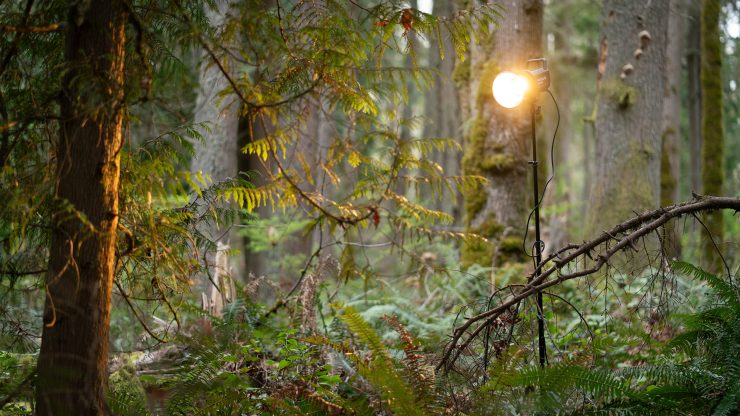

I grabbed a portable light stand, the Neewer FS150B, and the V-mount battery, and with the weight of the light, the equipment was no trouble at all to pack down the trail. When we found a good spot, I set the light to a warm 2700K, since the light was going simulate a low-in-the-sky sun.

Having forgotten the mount for my V-mount battery. I was glad that the cable was long enough to reach the ground, and I aimed the bare bulb and reflector through a gap in the trees to fall on the side of my model. Of course, a standard light stand is not ideal for the uneven ground of the forest floor, and something that could have raised the light a few more feet would have given me more flexibility, but I was happy with the results nonetheless. Of course, any battery powered strobe (like the one I reviewed last summer) would do this job just as well for shooting stills, but for video work, the FS150B provides the necessary powerful, constant light to get the job done.
This time, with the FS150B running at 100% power, I got about 20 minutes of life out of the PS099E V-mount battery, though I’ll need to do further testing to see whether that’s typical.
If the day had been brighter, I might have needed to wait until closer to sunset to get the effect that I wanted, but with the overcast skies, the light worked admirably.
Value: How Does it Compare to Similar Lights?
Currently1On April 8th, 2024, the Neewer FS150B is available on Amazon at an apparent “sale” price of $140, though it’s unclear where the regular price will settle. At this price, though, the light is a steal, and at it’s regular “list price” of $199, it’s still significantly less expensive than similar lights.
The SmallRig RC 120B is probably the closest option. It’s a bi-color 120W light with similar app controls, a similar but somewhat lower power output (52.8k lux vs. the Neewer’s 70k), a near-silent cooling fan, optional V-mount battery power, and app control. Its cost, though is quite a bit higher, at $.
Similarly, the Godox Litemons LA150Bi is a 190W bi-color light with similar light output, app-control and lighting effects and a similar (96 rather than 97) CRI rating, but it costs slightly more, is not designed for battery power, and we are given no information about fan noise.

The GVM Pro SD200B may be a slightly more expensive ($185.00) option to consider. The GVM is a more powerful, 200W light with a sturdy aluminum housing and otherwise virtually identical features to the Neewer FS150B, plus DMX in/outputs. Oddly, the GVM only claims an output of 45k lux of brightness, though this may be due to a difference in measurement range.
Again, even if the prices were identical, the Neewer light’s features match or exceed those of the competitors… but they also do it at a lower price. That seems like a great value.
Conclusion
Like Godox, Neewer is quickly gaining the reputation of a company that produces high-quality, professional-level equipment at reasonable prices, and the FS150B Bi-Color LED video light will certainly help in cementing that reputation.
I’ve fount the Neewer FS150B to be powerful, accurate, flexible and reliable, making it an excellent tool for professional use or for the hobbyist. The Neewer light is available at Amazon and B&H Photo, among other popular photo shops.

